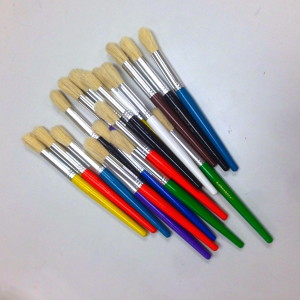It takes a lot of time to master all the marks and strokes we use when writing letters!
When learning their writing strokes, children first scribble, then at 2-3 years work on first vertical (up and down) strokes, then horizontal (left-to-right), then circular strokes. 4-5 year old preschoolers then work on crosses/pluses, squares, diagonal lines, and Xs. Once children have practice creating and copying these types of marks they can start to put them together to make letters.
Since coordination of large muscles is often easier at first for children than coordinating small muscles, practicing these strokes with larger arm movements is one way to play with these ideas. In addition, tracing or copying letters or shapes on paper before children are ready to can be frustrating and counterproductive. Instead, we are going to use paintbrushes to “write” on our bodies! I got these from Lakeshore Learning; they are large and soft.
Choose a book about painting to read in storytime. Possible titles are:
Ain’t Gonna Paint No More, by Karen Beaumont
Mouse Paint, by Ellen Stoll Walsh
Art & Max, by David Wiesner
Bear’s Picture, by Daniel Pinkwater
Warthogs Paint, by Pamela Edwards
Blue Chicken, by Deborah Freedman
Blue Goose, by Nancy Tafuri
Tap Tap Bang Bang, by Emma Garcia
Afterwards, tell the children you are going to pretend to paint just like the characters in the story! Pass out one paintbrush to each child. Depending on the age of the children, you might:
o Ask them to “paint” long straight lines on their legs, or circles on their knees.
o Ask them to “paint” different parts of their bodies (as in Ain’t Gonna Paint No More)
o Ask them to paint zigzags, rainbows, straight lines on the floor in front of them
o Ask them to paint letters of the alphabet on the floor in front of them
When you’re all done, say something like this to the grown-ups:
“Parents, when you give your children crayons, markers, pencils, and paintbrushes to play with, they start to learn how to hold and use pencils and crayons and experiment with making different lines and shapes. This helps them become good readers because reading skills and writing skills support each other and develop together. Writing with your children will help them get ready to read.”



.jpg)

6 Responses to Early Literacy Storytime: Paintbrushes